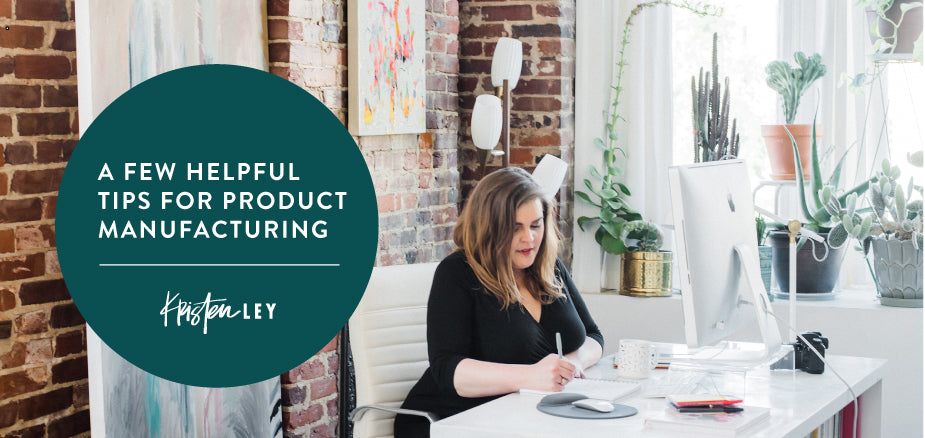Hey friends! Recently I launched The Ultimate Resources Guide in my shop. The guide is filled with resources, vendors, manufacturers, etc. Today I wanted to focus on the manufacturing aspect of it and give some tips I have when moving forward with product manufacturers be them in the United States or overseas.
1. Never be shy to contact a manufacturer because you don't feel qualified enough.
If I let that stop me, I would never have started Thimblepress. Just as you are wanting to design and create beautiful products, they want to make them for you. Even if you don't know what the heck you are talking about, that's ok. A good manufacturer will take their time with you and realize the value in what you are wanting to do. I know a lot of times I didn't always know the weight of the paper I wanted to print on or the foil process & color I wanted to use, but my printer would always sit down and patiently go through options that fit my style & budget. One of my favorite printers I work with is Jay Peoples of Service Printers in my home town of Jackson, MS. Jay takes time for people, and no he is not paying me to say this. Jay always takes the time to sit down with me, and I never feel like he is trying to up-sell me, cheat me out of money or go for a paper or quantity that is way out of my budget. Jay has toured me around the Service Printers facility many times. I've met all the people who print and foil stamp the products Thimblepress creates with them. This kind of experience is what you should have with a good manufacturer. Jay is facilitating a beautiful customer journey.
If you meet with someone who won't take the time of day to meet with you or kindly explain different options that can work within your budget, that manufacturer may not be the right fit for you. Kindness goes a long way in my book. At the end of the day, you are building a relationship with these manufacturers. You'll both experience up's together and possibly down's together. Go with your gut. If it doesn't feel right, it probably isn't right.
2. Always get the samples and proofs
This one is a FOR SURE in the manufacturing world. When it comes to manufacturing in the United States and especially if you are working with local manufacturers, you can most likely drive to the facilities and do a press check. When and if you decide to manufacturer overseas, samples are a must and can easily be sent to you for a price of anywhere from $50-$100 per sample.
Samples are crucial in overseas and domestic manufacturing. Even though we spell out all the details in our emails listing out paper sizes, foil colors, folds, Pantone® colors, etc. there is always a margin for error and things can literally get lost in translation. We are humans and humans make errors. Samples can save you thousands upon thousands of dollars on both your end and the manufacturers.
If your manufacturer is local ask to come in and do a press check or have one of the items manufactured for a fee before full production begins.
3. How many of a product should I order/manufacturer?
When I create products I like to first see if there is white space in the market for it. Is anyone else doing this? How much are the charging? I also always do my do diligence and homework. Once I realize I have something worth persuing I move forward into getting feedback from my target market. When I present the idea if their initial reaction isn't "WHERE CAN I BUY THIS NOW?!" I know there is still work to be done to make the product better. I then tweak it and revisit the feedback step. (SIDENOTE: Feedback doesn't mean you are letting people decide or control your brand / feedback is listening to your customers, your tribe and providing the best products you can for them & make the most sense for your brand.)
When I finally get to the step of deciding the quantity of product I am going to manufacturer, it all depends on if I am creating a variation of a product format I already create or if I am creating a completely new format or product category. When I am creating a product for a product category I already know well and know sells well, I can usually order more on the initial manufacturing round because I know it will most likely sell well. If it is a product category or format I have never introduced before I tend to start with a small number on my initial manufacturing of it. Why do I do that? Even though I received feedback from my target market, did market research, that is never a guarantee that it will sell well. If it sells well, then I will order more on the second round, but if it doesn't do as well as I anticipated I am not stuck with thousands of a product that doesn't move. Product sitting on a floor is just a pile of stale money collecting dust. Plus, the more products that sit, the more space you need to house all of them.
If you're really not sure about how your target market will react (even after feedback and focus groups) once it is actually for sale, there are a few ways to circumvent that. You can work with a print on demand company (I list off many in The Ultimate Resources Guide) or you can have your sample made and take pre-orders. I've done it all the ways. The only thing about pre-orders is you have to be very careful to make sure there are no blips in the manufacturing timeline otherwise you leave customers who were banking on receiving their product by a certain date very upset. It's a fine line we walk...
I hope these three tips were somewhat helpful to those who are curious about manufacturing products! Cheers! xo, Kristen

